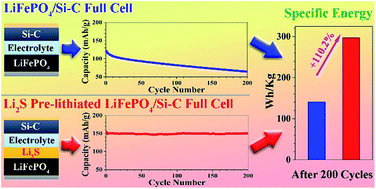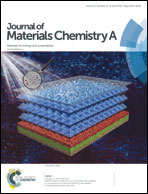Application of Li2S to compensate for loss of active lithium in a Si–C anode†
Abstract
Mixed silicon and carbon (Si–C) materials with high capacity are ideal candidates for the substitution of graphite or other carbon anodes in lithium-ion batteries. However, the low coulombic efficiency of the Si–C anode in the first cycle due to the formation of a solid electrolyte interphase and the consumption of active lithium have hindered its commercial applications. Here, we report using Li2S as a prelithiation material to compensate for the loss of active lithium in the first cycle and, consequently, to enhance the specific energy of lithium-ion batteries. The Si–C anode has an initial discharge specific capacity of ∼738 mA h g−1 and a charge specific capacity of ∼638 mA h g−1. The prelithiation material with a core–shell structure is prepared by mixing Li2S, Ketjenblack (KB) and poly(vinylpyrrolidone) (PVP) in anhydrous ethanol, which shows a high irreversible capacity of ∼1084 mA h g−1. The effect of the compensation of lost active lithium is verified via a LiFePO4 (Li2S)/Si–C full cell, which exhibits not only a high specific capacity but also a stable cycling performance. The specific energy of the LiFePO4 (Li2S)/Si–C full cell shows a remarkable increase compared to the LiFePO4/Si–C full cell, exhibiting ∼13.4%, ∼26.7%, ∼65.0% and ∼110.2% more specific energy after the 1st, 10th, 100th and 200th cycle, respectively.



 Please wait while we load your content...
Please wait while we load your content...